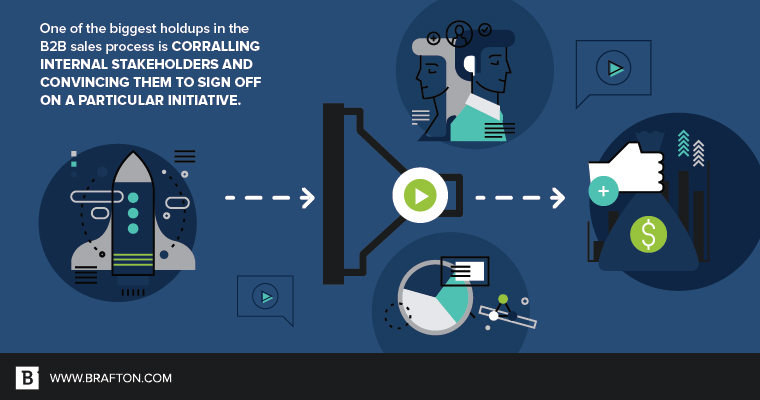Ever get bored sending the same templated email? Or opening every call with your go-to weather cliche?
Well, your prospects are sick of that, too.
Whatever your product or service may be, it’s your job as a marketer or salesperson to generate revenue. But sticking with yesterday’s pitches – cold calls, spammy ads, weird LinkedIn overtures, etc. – allows you only so much runway in 2017.
That’s why most brands are adopting video-centric messaging strategies that reach prospects at just the right moment in the sales process.
We spoke with Brafton’s Senior Director of Account Management Marlon Glover to demonstrate how video can be successfully deployed throughout the sales funnel and why it’s important to ask and answer the right questions.
Stage 1: Discovery phase – videos for problems
If we think of the sales process as four distinct stages of potential customer interaction, it’s easy to see just how widely different each prospect’s intent may be.
At the discovery phase of the journey, users are merely looking for information that scratches the surface of a problem they face.
Marlon stated these problems tend to be organizational in the B2B sphere. Example search queries may be:
- “How to train employees fast”
- “Data visualization tactics”
- “When to outsource to financial management”
These phrases clearly show users are struggling with specific business-related tasks at their companies. What better way to answer these questions than with explainer videos that show you understand these problems and have easy-to-digest answers on standby?
Stage 2: Learning phase – videos for benefits
Using one of the examples above (when to outsource financial management), let’s track the steps a user might take in learning more about who or what may be the answer to their problems.
Perhaps a time-strapped director of a mid-sized B2B firm is looking to unload the arduous financial and accounting processes that haven’t scaled in line with his or her company’s growth. But, it might not make business sense to continue to hire more staff to fix or rebuild the backend systems and procedures that are broken.
In this case, the director is probably asking similar questions, such as:
- “How much does financial management software cost?”
- “How long does it take to integrate accounting software?”
- “What are the pros and cons of outsourcing to an F&A vendor?”
If your company operates in this space, or provides this type of service, then videos extolling the benefits of your offerings could work wonders.

The prospect is gathering more information through personal research, but is also likely looping in other stakeholders at his or her company for their opinions. Further, a specific person at the company may have already been assigned the task of setting up calls with five different vendors that offer the same competing service as you.
As the scope of the journey comes into closer focus, the intent of the user is much more targeted – the same should go for your videos.
After an initial micro conversion (asset download, newsletter subscription, etc.) or even the first call with a warm lead, delivering product demos, 360-degree feature videos, animations and testimonials directly to his or her inbox can be highly effective. You understand their pain points and their needs, and you’re acting on this knowledge.
Stage 3: Decision phase – videos for stakeholders
Reviewing the bids of several vendors can take weeks or months. Marlon noted that one of the biggest holdups in the B2B sales process is corralling internal stakeholders and convincing them to sign off on a particular initiative.
If you’re creating videos to woo prospects, you also need to be creating videos that wow those prospects’ bosses.
Most marketers or salespeople don’t have the full authority to make autonomous purchasing decisions. Depending on the company, at some point, they’ll have to loop in various specialists and those on their teams who have influence with the final decision-maker: the CEO or CFO, for instance.
What if you had a video that simplified all the advantages of your product or service, and then highlighted specific costs and ROI that are involved?
“At this stage, stakeholders only care about costs,” Marlon said.
A breadth of service video that can be passed around internally has a very distinct objective: narrowing down service providers to a single option. In this sense, your videos are throwing a bone to prospects and making it easier for them to gain the approval they need to say yes to you.
At this stage, stakeholders only care about costs.
If you can’t convince those who hold the purse strings, you’re missing a step in your sales efforts.
Make sure these two concepts are aligned.
Stage 4: Purchasing phase – videos for a sale
The final purpose that video serves in the B2B sales process is closing the deal. At this point, Marlon often operates from the standpoint of, “What’s the last thing stopping a prospect from signing? Is it the contractual agreement? The legal obstacles they have to smooth out? Whatever it is, video can help provide the final push to get the sale over the finish line.”
For a B2B company, it can take a year to sell a single complex product like software. If you provide financial management software, for example, everything hinges upon this final moment before a prospect puts the pen to paper and inks the deal, meaning there’s little room for error.
Video can help provide the final push to get the sale over the finish line.
Your prospects are likely equally on edge – they want to be 100 percent sure they’re making the smartest decision.
A short video that provides a gentle reassurance of who they may be working with (you), the commitments you make to customers and how easy it is to do business with your company can go a long way in warming up prospects’ cold feet.
If you’re unclear on what type of video could do justice to your prospects’ feelings at this stage, Marlon recommended, “Start with messaging. It has to be something [the client] finds important. The style of the video matters less, as long as it’s done efficiently.”
A series of testimonials from other satisfied customers is typically a go-to at this stage – just be sure they are customized to the pain points of each prospect.
If you’re looking for a jumping-off point to bring your video strategy to life, Marlon suggested asking yourself these few questions:
- “What questions often come up in the sales process?”
- “Where do deals typically get stuck?”
- “What are preconceived ideas/notions that prospects have before they interact with my business?”
Knowing these answers allows you to hone in on specific messaging that should be deployed at each stage of the sales process and should enable your video team to focus less on products and more on customer needs.
This year is already shaping up to be the “Year of Video,” and metrics show that video is instrumental in driving ROI – so what are you waiting for?





